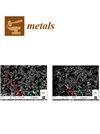通过两步退火热处理的中锰钢的微观结构演变和拉伸性能
IF 2.5
3区 材料科学
Q3 MATERIALS SCIENCE, MULTIDISCIPLINARY
引用次数: 0
摘要
本文通过两步退火工艺控制奥氏体的成核和生长,实现了低锰系列中锰钢的多尺度分布和残余奥氏体含量的增加。结合 SEM、EBSD、AES 等实验设备,研究了退火过程中试验钢的显微组织、性能和元素分布行为的演变规律。与一步退火相比,两步退火显著拓宽了残余奥氏体的尺寸分布范围。第一步,在较高的临界温度(760 °C)下退火后,获得铁素体和 M/A 岛,完成锰的初始分配和微观结构的细化。在第二步退火(720 °C)期间,原生富锰马氏体区提供了更高的成核驱动力和更细小分散的成核点,促进了反转变奥氏体的成核和生长。同时,第一步退火后形成的可转移保留奥氏体通过界面运动继续生长。此外,在最终的微观结构中形成了高比例(23.4%)的多尺度分布的残余奥氏体,强度和伸长率的乘积从一步退火工艺的 21.8 GPa-% 增加到 30.1 GPa-%。本文章由计算机程序翻译,如有差异,请以英文原文为准。
Microstructure Evolution and Tensile Properties of Medium Manganese Steel Heat Treated by Two-Step Annealing
In this paper, the nucleation and growth of austenite are controlled through a two-step annealing process to achieve multi-scale distribution and content increase of retained austenite in low manganese series medium-Mn steel. Combining SEM, EBSD, AES, and other experimental equipment, the evolution rules of the microstructure, properties, and element distribution behavior of the test steel during the annealing process are studied. Compared with one-step annealing, the two-step annealing significantly broadens the size distribution range of retained austenite. In the first step, after annealing at a higher intercritical temperature (760 °C), the ferrite and the M/A island are obtained, completing the initial partition of Mn and the refinement of microstructures. During the second step of annealing (720 °C), the primary Mn-rich martensite region provides higher nucleation driving force and finer dispersed nucleation sites, promoting the nucleation and growth of reverse transformation austenite. At the same time, the metastable-retained austenite formed after the first step of annealing continues to grow through interface movement. Furthermore, a high proportion (23.4%) of retained austenite with multi-scale distribution is formed in the final microstructure, and the product of strength and elongation increased from 21.8 GPa·% by the one-step annealing process to 30.1 GPa·%.
求助全文
通过发布文献求助,成功后即可免费获取论文全文。
去求助
来源期刊

Metals
MATERIALS SCIENCE, MULTIDISCIPLINARY-METALLURGY & METALLURGICAL ENGINEERING
CiteScore
4.90
自引率
13.80%
发文量
1832
审稿时长
1.5 months
期刊介绍:
Metals (ISSN 2075-4701) is an open access journal of related scientific research and technology development. It publishes reviews, regular research papers (articles) and short communications. Our aim is to encourage scientists to publish their experimental and theoretical results in as much detail as possible. Therefore, there is no restriction on the length of the papers. The full experimental details must be provided so that the results can be reproduced. Metals provides a forum for publishing papers which advance the in-depth understanding of the relationship between the structure, the properties or the functions of all kinds of metals.
 求助内容:
求助内容: 应助结果提醒方式:
应助结果提醒方式:


